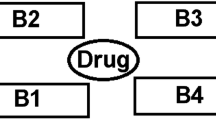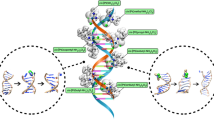Abstract
Molecular dynamics simulations and umbrella sampling have been used to investigate the sliding of distamycin anticancer drug along the DNA minor groove. The potential energy surface calculated for the sliding of drug shows three minima. The global minimum corresponds to the binding of drug to the AT-rich region, which is the origin of sequence selectivity of distamycin. This selectivity originates from both structural factors and energy contributions. The analysis of energy contributions of binding was performed by the MM–PBSA method. The analysis of hydrogen bonds and van der Waals, electrostatic, and solvation interactions show that structural or steric factors are more important in the selectivity of distamycin than energetic factors. The results of this study can be applied in the design of new derivatives of distamycin anticancer drug with improved properties.





Similar content being viewed by others
References
R. Palchaudhuri, P.J. Hergenrother, DNA as a target for anticancer compounds: methods to determine the mode of binding and the mechanism of action. Curr. Opin. Biotechnol. 18(6), 497–503 (2007)
L.H. Nahid Shahabadi, Binding studies of the antidiabetic drug, metformin to calf thymus DNA using multispectroscopic methods. Spectrochim. Acta Part A Mol. Biomol. Spectrosc. 97, 406–410 (2012)
J.J. Gills, J. LoPiccolo, P.A. Dennis, Nelfinavir, a new anti-cancer drug with pleiotropic effects and many paths to autophagy. Autophagy 4(1), 107–109 (2008)
B.P. Reddy, S.M. Sondhi, J.W. Lown, Synthetic DNA minor groove-binding drugs. Pharmacol. Ther. 84(1), 1–111 (1999)
R. Palchaudhuri, P.J. Hergenrother, DNA as a target for anticancer compounds: methods to determine the mode of binding and the mechanism of action. Curr. Opin. Biotechnol. 18, 497–503 (2007)
L. Ls, Structural considerations in the interaction of DNA and acridines. J. Mol. Biol. 3, 18–30 (1961)
M. Brana et al., Intercalators as anticancer drugs. Curr. Pharm. Des. 7(17), 1745–1780 (2001)
L. Lerman, Structural considerations in the interaction of DNA and acridines. J. Mol. Biol. 3(1), 18IN13–30IN14 (1961)
B.S.P. Reddy, S.M. Sodhi, J.W. Lown, Synthetic DNA minor groove-binding drugs. Pharmacol. Ther. 84, 1–111 (1999)
C. Bailly, J.P. Henichart, DNA recognition by intercalator-minor-groove binder hybrid molecules. Bioconjug. Chem. 2, 379–393 (1991)
J. Bc, Energetics of drug–DNA interactions. Biopolymers 44, 201–215 (1997)
C. Zimmer, U. Wähnert, Nonintercalating DNA-binding ligands: specificity of the interaction and their use as tools in biophysical, biochemical and biological investigations of the genetic material. Prog. Biophys. Mol. Biol. 47, 31–112 (1986)
P.G. Baraldi, M.A. Tabrizi, D. Preti, F. Fruttarolo, B. Avitabile, A. Bovero, G. Pavani, M. Carmen Nunez del Carretero, R. Romagnoli, DNA minor-groove binders. Design, synthesis, and biological evaluation of ligands structurally related to CC-1065, distamycin, and anthramycin. Pure Appl. Chem. 75, 187–194 (2003)
P. Cozzi, A new class of cytotoxic DNA minor groove binders: α-halogenoacrylic derivatives of pyrrolecarbamoyl oligomers. 56, 57–65 (2001)
T.J. Dwyer, B.H. Geierstanger, Y. Bathini, J.W. Lown, D.E. Wemmer, Design and binding of a distamycin A analog to d(CGCAAGTTGGC)–d(GCCAACTTGCG): synthesis, NMR studies, and implications for the design of sequence-specific minor groove binding oligopeptides. J. Am. Chem. Soc. 114, 5911–5919 (1992)
M. D’Incalci, C. Sessa, Review oncologic, endocrine & metabolic DNA minor groove binding ligands: a new class of anticancer agents. Exp. Opin. Invest. Drugs 6, 875–884 (1997)
H.C. Nelson et al., The structure of an oligo (dA)· oligo (dT) tract and its biological implications. Nature 330(6145), 221–226 (1987)
B. Pullman, Electrostatics of polymorphic DNA. J. Biomol. Struct. Dyn. 1(3), 773–794 (1983)
M.L. Kopka et al., The molecular origin of DNA–drug specificity in netropsin and distamycin. Proc. Natl. Acad. Sci. 82(5), 1376–1380 (1985)
M. Broggini, M. D’Incalci, Modulation of transcription factor DNA interaction by anticancer drugs. Anticancer Drug Des. 9, 373–387 (1994)
M. Broggini et al., Selective DNA interaction of the novel distamycin derivative FCE 24517. Cancer Res. 51(1), 199–204 (1991)
K. Uytterhoeven, J. Sponer, L. Van Meervelt, Two 1:1 binding modes for distamycin in the minor groove of d(GGCCAATTGG). Eur. J. Biochem. 269, 2868–2877 (2002)
T.A. Steitz, Structural studies of protein–nucleic acid interaction: the sources of sequence-specific binding. Q. Rev. Biophys. 23(3), 205–280 (1990)
M. Coll et al., A bifurcated hydrogen-bonded conformation in the d (AT) base pairs of the DNA dodecamer d (CGCAAATTTGCG) and its complex with distamycin. Proc. Natl. Acad. Sci. 84(23), 8385–8389 (1987)
D.A. Pearlman et al., AMBER, a package of computer programs for applying molecular mechanics, normal mode analysis, molecular dynamics and free energy calculations to simulate the structural and energetic properties of molecules. Comput. Phys. Commun. 91(1), 1–41 (1995)
K. Boehncke et al., Molecular dynamics investigation of the interaction between DNA and distamycin. Biochemistry 30(22), 5465–5475 (1991)
S.B. Singh, D.E. Wemmer, P.A. Kollman, Relative binding affinities of distamycin and its analog to d(CGCAAGTTGGC). d(GCCAACTTGCG): comparison of simulation results with experiment. Proc. Natl. Acad. Sci. 91(16), 7673–7677 (1994)
M.V. Koonammackal, U.V.N. Nellipparambil, C. Sudarsanakumar, Molecular dynamics simulations and binding free energy analysis of DNA minor groove complexes of curcumin. J. Mol. Model. 17(11), 2805–2816 (2011)
J. Dolenc et al., Molecular dynamics simulations and free energy calculations of netropsin and distamycin binding to an AAAAA DNA binding site. Nucleic Acids Res. 33(2), 725–733 (2005)
K. Wittayanarakul et al., Ranking ligand affinity for the DNA minor groove by experiment and simulation. ACS Med. Chem. Lett. 1(8), 376–380 (2010)
B.M. Pettitt, M. Karplus, The potential of mean force surface for the alanine dipeptide in aqueous solution: a theoretical approach. Chem. Phys. Lett. 121(3), 194–201 (1985)
J.G. Kirkwood, Statistical mechanics of fluid mixtures. J. Chem. Phys. 3(5), 300–313 (1935)
G.M. Torrie, J.P. Valleau, Monte Carlo free energy estimates using non-Boltzmann sampling: application to the sub-critical Lennard–Jones fluid. Chem. Phys. Lett. 28(4), 578–581 (1974)
B. Roux, The calculation of the potential of mean force using computer simulations. Comput. Phys. Commun. 91(1), 275–282 (1995)
A.V. Vargiu et al., Sliding of alkylating anticancer drugs along the minor groove of DNA: new insights on sequence selectivity. Biophys. J. 94(2), 550–561 (2008)
M. Zacharias, Minor groove deformability of DNA: a molecular dynamics free energy simulation study. Biophys. J. 91(3), 882–891 (2006)
W.L. Jorgensen et al., Comparison of simple potential functions for simulating liquid water. J. Chem. Phys. 79(2), 926–935 (1983)
J. Aaqvist, Ion–water interaction potentials derived from free energy perturbation simulations. J. Phys. Chem. 94(21), 8021–8024 (1990)
T.I. Cheatham et al., Molecular dynamics simulations on solvated biomolecular systems: the particle mesh Ewald method leads to stable trajectories of DNA, RNA, and proteins. J. Am. Chem. Soc. 117(14), 4193–4194 (1995)
J.-P. Ryckaert, G. Ciccotti, H.J. Berendsen, Numerical integration of the Cartesian equations of motion of a system with constraints: molecular dynamics of n-alkanes. J. Comput. Phys. 23(3), 327–341 (1977)
H.C. Andersen, Molecular dynamics simulations at constant pressure and/or temperature. J. Chem. Phys. 72(4), 2384–2393 (1980)
D. Case, et al., in AMBER 10; University of California, San Francisco, 2008, 2005
J. Wang et al., Automatic atom type and bond type perception in molecular mechanical calculations. J. Mol. Graph. Model. 25(2), 247–260 (2006)
J. Wang et al., Development and testing of a general amber force field. J. Comput. Chem. 25(9), 1157–1174 (2004)
J. Wang, P. Cieplak, P.A. Kollman, How well does a restrained electrostatic potential (RESP) model perform in calculating conformational energies of organic and biological molecules? J. Comput. Chem. 21(12), 1049–1074 (2000)
W. Cornell, et al., in A 2nd-Generation Force-Field for the Simulation of Proteins, Nucleic-Acids, and Small Molecules. Abstracts of Papers of the American Chemical Society (American Chemical Society, Washington, DC, 1992)
T.E. Cheatham III, P. Cieplak, P.A. Kollman, A modified version of the Cornell et al. force field with improved sugar pucker phases and helical repeat. J. Biomol. Struct. Dyn. 16(4), 845–862 (1999)
J.M. Rosenbergl, The weighted histogram analysis method for free-energy calculations on biomolecules. I. The method. J. Comput. Chem. 13(8), 1011–1021 (1992)
A. Grossfield, in WHAM (Rochester, 2003)
J. Srinivasan et al., Continuum solvent studies of the stability of DNA, RNA, and phosphoramidate–DNA helices. J. Am. Chem. Soc. 120(37), 9401–9409 (1998)
P.A. Kollman et al., Calculating structures and free energies of complex molecules: combining molecular mechanics and continuum models. Acc. Chem. Res. 33(12), 889–897 (2000)
B.R. Miller III et al., MMPBSA. py: an efficient program for end-state free energy calculations. J. Chem. Theory Comput. 8(9), 3314–3321 (2012)
J. Weiser, P.S. Shenkin, W.C. Still, Approximate atomic surfaces from linear combinations of pairwise overlaps (LCPO). J. Comput. Chem. 20(2), 217–230 (1999)
C. Tan, Y.-H. Tan, R. Luo, Implicit nonpolar solvent models. J. Phys. Chem. B 111(42), 12263–12274 (2007)
D. Sitkoff, K.A. Sharp, B. Honig, Accurate calculation of hydration free energies using macroscopic solvent models. J. Phys. Chem. 98(7), 1978–1988 (1994)
B. Honig, A. Nicholls, Classical electrostatics in biology and chemistry. Science 268(5214), 1144–1149 (1995)
M.K. Gilson, K.A. Sharp, B.H. Honig, Calculating the electrostatic potential of molecules in solution: method and error assessment. J. Comput. Chem. 9(4), 327–335 (1988)
H. Gohlke, C. Kiel, D.A. Case, Insights into protein–protein binding by binding free energy calculation and free energy decomposition for the Ras–Raf and Ras–RalGDS complexes. J. Mol. Biol. 330(4), 891–913 (2003)
H. Gohlke, D.A. Case, Converging free energy estimates: MM–PB (GB) SA studies on the protein–protein complex Ras–Raf. J. Comput. Chem. 25(2), 238–250 (2004)
S.B. Rempe, H. Jónsson, A computational exercise illustrating molecular vibrations and normal modes. Chem. Educ. 3(4), 1–17 (1998)
S. Hayward, A. Kitao, N. Gō, Harmonicity and anharmonicity in protein dynamics: a normal mode analysis and principal component analysis. Proteins Struct. Funct. Bioinform. 23(2), 177–186 (1995)
R. Lavery et al., Conformational analysis of nucleic acids revisited: Curves+. Nucleic Acids Res. 37(17), 5917–5929 (2009)
T.J. Dwyer et al., Design and binding of a distamycin A analog to d (CGCAAGTTGGC). cntdot. d (GCCAACTTGCG): synthesis, NMR studies, and implications for the design of sequence-specific minor groove binding oligopeptides. J. Am. Chem. Soc. 114(15), 5911–5919 (1992)
J. Dolenc et al., Configurational entropy change of netropsin and distamycin upon DNA minor-groove binding. Biophys. J. 91(4), 1460–1470 (2006)
T.A. Soares et al., An improved nucleic acid parameter set for the GROMOS force field. J. Comput. Chem. 26(7), 725–737 (2005)
T.E. Cheatham, M.A. Young, Molecular dynamics simulation of nucleic acids: successes, limitations, and promise. Biopolymers 56(4), 232–256 (2000)
D.R. Roe, T.E. Cheatham III, PTRAJ and CPPTRAJ: software for processing and analysis of molecular dynamics trajectory data. J. Chem. Theory Comput. 9(7), 3084–3095 (2013)
S. Pronk et al., GROMACS 4.5: a high-throughput and highly parallel open source molecular simulation toolkit. Bioinformatics 29(7), 845–854 (2013)
D. Van Der Spoel et al., GROMACS: fast, flexible, and free. J. Comput. Chem. 26(16), 1701–1718 (2005)
R. Luo, L. David, M.K. Gilson, Accelerated Poisson–Boltzmann calculations for static and dynamic systems. J. Comput. Chem. 23(13), 1244–1253 (2002)
Author information
Authors and Affiliations
Corresponding author
Electronic supplementary material
Below is the link to the electronic supplementary material.
Rights and permissions
About this article
Cite this article
Jalili, S., Maddah, M. Molecular dynamics simulation of the sliding of distamycin anticancer drug along DNA: interactions and sequence selectivity. J IRAN CHEM SOC 14, 531–540 (2017). https://doi.org/10.1007/s13738-016-1001-0
Received:
Accepted:
Published:
Issue Date:
DOI: https://doi.org/10.1007/s13738-016-1001-0




